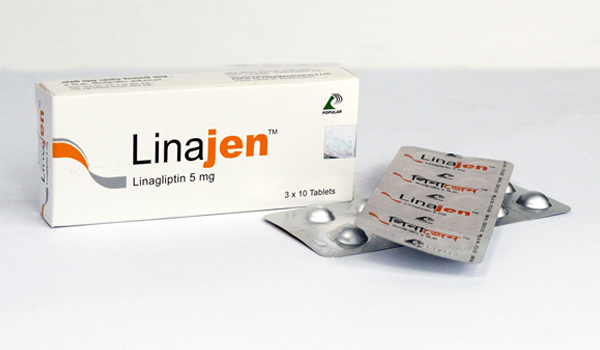Indication
Linagliptin is indicated for use in type 2 diabetes as monotherapy (if Metformin Hydrochloride inappropriate) or in combination with Metformin Hydrochloride (when treatment with Metformin Hydrochloride alone fails to achieve adequate glycaemic control) or both Metformin Hydrochloride and a Sulfonylurea (when dual therapy with these drugs fails to achieve adequate glycaemic control). Linagliptin may also be used in combination with Insulin (with or without Metformin Hydrochloride) when a stable dose of Insulin has not provided adequate glycaemic control.
Dosage & Administration
The dose of Linagliptin is 5 mg once daily. When Linagliptin is added to metformin, the dose of metformin should be maintained and Linagliptin administered concomitantly.When Linagliptin is used in combination with a Sulphonylurea or with Insulin, a lower dose of the sulphonylurea or insulin, may be considered to reduce the risk of hypoglycaemia.
Special Populations
Renal Impairment: For patients with renal impairment, no dose adjustment for Linagliptin is required.
Hepatic Impairment: Pharmacokinetic studies suggest that no dose adjustment is required for patients with hepatic impairment but clinical experience in such patients is lacking.
Elderly: No dose adjustment is necessary based on age. However, clinical experience in patients > 80 years of age is limited and caution should be exercised when treating this population.
Paediatric Population: The safety and efficacy of Linagliptin in children and adolescents has not yet been established. No data are available.
Gender: No dose adjustment is necessary based on gender. Gender had no clinically meaningful effect on the pharmacokinetics of Linagliptin based on a population pharmacokinetic analysis.
Race: No dose adjustment is necessary based on race. Race had no clinically meaningful effect on the pharmacokinetics of Linagliptin based on available pharmacokinetic data, including subjects of White, Hispanic, Black, and Asian racial groups.
Body Mass Index (BMI)/Weight : No dose adjustment is necessary based on BMI/weight. BMI/weight had no clinically meaningful effect on the pharmacokinetics of Linagliptin based on a population pharmacokinetic analysis. The clinical trials before marketing authorization have been performed up to a BMI equal to 40 kg/m2.
Method of Administration
The tablets can be taken with or without a meal at any time of the day. If a dose is missed, it should be taken as soon as the patient remembers. A double dose should not be taken on the same day.
Precautions
- There have been postmarketing reports of acute pancreatitis, If pancreatitis is suspected, promptly discontinue Linagliptin.
- When used with an insulin secretagogue (e.g., Sulfonylurea) or Insulin, consider lowering the dose of the insulin secretagogue or insulin to reduce the risk of hypoglycemia.
- There have been postmarketing reports of serious hypersensitivity reactions in patients treated with Linagliptin including anaphylaxis, angioedema, and exfoliative skin conditions. In such cases, promptly discontinue Linagliptin, assess for other potential causes, institute appropriate monitoring and treatment, and initiate alternative treatment for diabetes.
- Severe and disabling arthralgia has been reported in patients taking DPP-4 inhibitors. Consider as a possible cause for severe joint pain and discontinue drug if appropriate.
- There have been postmarketing reports of bullous pemphigoid requiring hospitalization in patients taking DPP-4 inhibitors. If bullous pemphigoid is suspected, discontinue Linagliptin.
Fertility, Pregnancy and Lactation
Pregnancy : The use of Linagliptin has not been studied in pregnant women. Animal studies do not indicate direct or indirect harmful effects with respect to reproductive toxicity. As a precautionary measure, it is preferable to avoid the use of Linagliptin during pregnancy.
Breast-feeding: Available pharmacokinetic data in animals have shown excretion of Linagliptin/metabolites in milk. A risk to the breast-fed child cannot be excluded. A decision must be made whether to discontinue breast - feeding or to discontinue/abstain from Linagliptin therapy taking into account the benefit of breast-feeding for the child and the benefit of therapy for the woman.
Fertility: No studies on the effect on human fertility have been conducted for Linagliptin. Animal studies do not indicate direct or indirect harmful effects with respect to fertility.
Effects on Ability to Drive and Use Machines
Linagliptin has no or negligible influence on the ability to drive and use machines. However patients should be alerted to the risk of hypoglycaemia especially when combined with sulphonylurea or insulin

